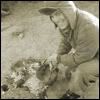Post by Woodard on Nov 18, 2007 17:58:54 GMT -5
First, let me start by saying I didn't like the way this book was written. It's basically the guy's notebook diary from the last few months of the Korean war. Sometimes it rambles, and the guy sounds like some kind of wannabe academic. Skip the first 30 pages or so, it's just about him being dramatic and trying to get laid before he left.
After saying all that, If you have any interest in the last phase of the war, or small unit action and patrolling, then you really have to read this one. The whole book is basically this guy going on patrols, and the guy included sketches of terrain, positions, ect. He was a Marine, so I'll be looking for similar books by Soldiers in order to compare. The sketches make it probably one of the easier to follow military books I've read.
Things of interest to reenactors/Living historians:
This guy served with 1st Ordnance battalion and with 1st Marines. He gives a list of what winter gear he was issued before he left (Oct 27, 1952). And I quote:
Canvas clothing bag, waterproof
Mountain brush (a small whisk broom, for mud and snow)
polarized sunglasses
trouser suspenders
shell gloves (rough chamois)
wool gloves, two pairs
mittens w/ trigger finger
mitten inserts
winter underwear (long johns), two pairs
parka w/ hood
cotton cap
wool scarf
alpaca lined vest w/ zipper
high necked wool sweater
cold weather trousers, two pairs
mountian sleeping bag
thermal boots
I have no idea what he means by mountain brush or cotton cap (M43 or M51?). The alpaca lined vest is a Marine only item, although the Air force may have used them at one point. At one point his brother in the Army visits him, and he mentions something about him wearing a "Mongolian style hat with his rank pinned on the upturned bill". This sounds like it has to be a pile cap, although I don't know why he wouldn't be familiar with it, unless he hadn't been issued one. At another point in the book he mentions them all having air mattresses (very end of the book, like a few days after the cease fire). He first saw the new M26 fragmentation grenade on April 14, 1953. He mentions them all having a "geneva convention" card that was supposed to be carried. Also seems like when a patrol came back in they were usually provided with coffee and doughnuts.
Hope this helps, I encourage anyone reading a book about Korea to take notes of details like this and post them.
After saying all that, If you have any interest in the last phase of the war, or small unit action and patrolling, then you really have to read this one. The whole book is basically this guy going on patrols, and the guy included sketches of terrain, positions, ect. He was a Marine, so I'll be looking for similar books by Soldiers in order to compare. The sketches make it probably one of the easier to follow military books I've read.
Things of interest to reenactors/Living historians:
This guy served with 1st Ordnance battalion and with 1st Marines. He gives a list of what winter gear he was issued before he left (Oct 27, 1952). And I quote:
Canvas clothing bag, waterproof
Mountain brush (a small whisk broom, for mud and snow)
polarized sunglasses
trouser suspenders
shell gloves (rough chamois)
wool gloves, two pairs
mittens w/ trigger finger
mitten inserts
winter underwear (long johns), two pairs
parka w/ hood
cotton cap
wool scarf
alpaca lined vest w/ zipper
high necked wool sweater
cold weather trousers, two pairs
mountian sleeping bag
thermal boots
I have no idea what he means by mountain brush or cotton cap (M43 or M51?). The alpaca lined vest is a Marine only item, although the Air force may have used them at one point. At one point his brother in the Army visits him, and he mentions something about him wearing a "Mongolian style hat with his rank pinned on the upturned bill". This sounds like it has to be a pile cap, although I don't know why he wouldn't be familiar with it, unless he hadn't been issued one. At another point in the book he mentions them all having air mattresses (very end of the book, like a few days after the cease fire). He first saw the new M26 fragmentation grenade on April 14, 1953. He mentions them all having a "geneva convention" card that was supposed to be carried. Also seems like when a patrol came back in they were usually provided with coffee and doughnuts.
Hope this helps, I encourage anyone reading a book about Korea to take notes of details like this and post them.


